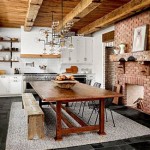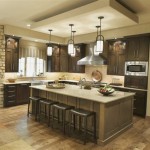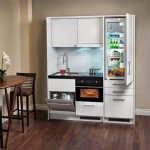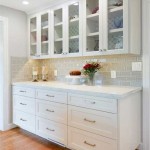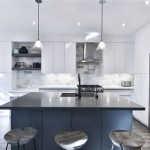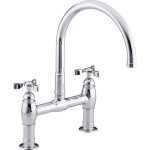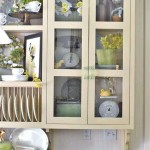Mid-Century Modern Kitchen Wallpaper: A Design Staple
Mid-Century Modern (MCM) design, a movement that flourished from the mid-1940s to the 1960s, continues to exert a significant influence on contemporary interior design. Its emphasis on clean lines, organic forms, functionality, and a celebration of natural materials resonates strongly with those seeking a timeless and sophisticated aesthetic. In the kitchen, a space often considered the heart of the home, MCM principles can be beautifully applied through various elements, and wallpaper plays a crucial role in capturing the essence of this iconic style.
Wallpaper in a Mid-Century Modern kitchen serves not merely as a decorative element but as a powerful design tool. It can establish the overall mood, introduce color and pattern, and complement the clean lines of cabinets and furniture. Properly selected, wallpaper can enhance the vintage appeal while seamlessly integrating with modern appliances and fixtures. Understanding the key features and design considerations of MCM wallpaper is essential for achieving a cohesive and authentic look.
Defining Characteristics of Mid-Century Modern Wallpaper
Several distinctive characteristics define Mid-Century Modern wallpaper. These elements, often inspired by nature, geometric abstraction, and technological advancements of the era, contribute to the overall visual language of the style.
Geometric Patterns: Geometric motifs were a hallmark of MCM design. Wallpaper featuring repeating patterns of shapes like squares, circles, triangles, and diamonds was highly prevalent. These patterns often displayed a sense of mathematical precision and order, reflecting the burgeoning interest in science and technology during the period. The scale of the patterns varied, from small, intricate designs to larger, bolder statements. Color palettes typically involved contrasting hues, though variations in tone and depth were also employed to create subtle visual interest. Consider the arrangement of geometric shapes. Are they uniform and symmetrical, or do they incorporate asymmetry and dynamic movement? The choice of arrangement significantly affects the overall feel of the space.
Abstract Motifs: Beyond rigid geometry, abstract designs were also common in MCM wallpaper. These designs moved away from literal representation, instead employing organic shapes, fluid lines, and textured surfaces to create visually engaging patterns. Inspired by the abstract expressionist art movement, these motifs often aimed to evoke emotions or ideas through the interplay of form and color. The use of negative space was often important, allowing the individual elements of the design to breathe and preventing the wallpaper from feeling overwhelming. Consider the flow and rhythm of the abstract forms. Do they create a sense of energy, or do they convey a feeling of calm and tranquility? The intended mood of the kitchen will influence the selection of an appropriate abstract pattern.
Atomic and Space-Age Designs: The mid-20th century witnessed unprecedented advancements in science and technology, particularly in the realm of nuclear physics and space exploration. These advancements profoundly influenced design aesthetics, leading to the incorporation of atomic and space-age motifs in wallpaper. Designs featuring stylized representations of atoms, orbits, and celestial bodies were popular choices. These motifs often symbolized progress, innovation, and a sense of optimism about the future. These designs often incorporate vibrant colors and bold contrasts to reflect the energy of the era. The use of metallic inks and textured surfaces can further enhance the futuristic appeal of these wallpapers.
Nature-Inspired Patterns: While geometric and abstract designs dominated, nature-inspired patterns also found a place in Mid-Century Modern wallpaper. These patterns often featured stylized representations of leaves, flowers, birds, and other natural elements. However, unlike traditional floral patterns, MCM nature-inspired designs typically employed simplified forms and bold colors. The goal was not to create realistic depictions of nature but rather to capture its essence in a modern and stylized way. The use of repeating patterns and symmetrical arrangements contributed to the overall sense of order and harmony. Consider incorporating nature inspired patterns that reflect local flora and fauna to create a sense of connection to the surrounding environment.
Color Palettes of Mid-Century Modern Wallpaper
Color plays a vital role in defining the aesthetic of Mid-Century Modern wallpaper. The color palettes of the era reflected a departure from the muted tones of previous decades, embracing bolder and more vibrant hues, often combined in unexpected ways.
Earthy Tones: Earthy tones, such as avocado green, mustard yellow, burnt orange, and olive green, were popular choices for MCM wallpaper. These colors evoked a sense of warmth, comfort, and connection to nature. They often served as a backdrop for bolder accent colors and complemented the natural materials used in furniture and cabinetry. The use of variations in tone and depth within the same color family, such as mixing light and dark shades of green or brown, created a more sophisticated and layered look. Consider how natural light affects the perception of earthy tones in the kitchen. Darker shades may create a cozy and intimate atmosphere, while lighter shades can help to brighten and expand the space.
Bold and Vibrant Hues: In contrast to the earthy tones, Mid-Century Modern design also embraced bold and vibrant colors, such as turquoise, coral, pink, and chartreuse. These colors often served as accent hues, adding pops of energy and visual interest to the space. They were frequently used in combination with neutral backgrounds to create a striking contrast. The juxtaposition of contrasting colors, such as turquoise and orange or pink and green, was a common design technique. The use of saturated colors was also prevalent, reflecting the optimism and exuberance of the era. Consider the psychological impact of different colors. Bright and vibrant colors can stimulate appetite and conversation, while cooler colors can create a sense of calm and relaxation.
Neutrals with Warm Undertones: While bold colors were characteristic of MCM design, neutral colors also played an important role. However, unlike the cool grays and whites of contemporary design, MCM neutrals typically had warm undertones, such as beige, cream, and off-white. These warm neutrals provided a softer and more inviting backdrop for the bolder accent colors and helped to create a sense of balance and harmony. The use of textured wallpaper in neutral tones added visual interest and depth to the space. Consider how the warm undertones in neutral wallpaper can complement the natural wood tones in cabinets and furniture. This creates a cohesive and inviting atmosphere.
Metallic Accents: Metallic accents, such as gold, silver, and copper, were frequently incorporated into MCM wallpaper to add a touch of glamour and sophistication. These metallic elements were often used to highlight key features of the design or to create a subtle shimmer and texture. The use of metallic inks and foil printing techniques was common, enhancing the visual impact of the wallpaper. The juxtaposition of metallic accents with matte finishes created an interesting contrast and added depth to the design. Consider using metallic accents sparingly to avoid overwhelming the space. A subtle touch of shimmer can be more effective than a bold and excessive display.
Practical Considerations for Choosing Kitchen Wallpaper
Beyond the aesthetic considerations, several practical factors must be taken into account when selecting wallpaper for a Mid-Century Modern kitchen. The kitchen environment presents unique challenges, such as moisture, grease, and frequent cleaning, which can impact the durability and longevity of the wallpaper.
Moisture Resistance: The kitchen is a humid environment, especially during cooking and dishwashing. Therefore, it is crucial to choose wallpaper that is specifically designed to be moisture-resistant. Vinyl-coated wallpapers are a popular choice because they are durable, water-resistant, and easy to clean. Breathable wallpaper materials can be used in areas with low humidity, such as near windows or countertops on the opposite side of stove or dishwasher. Avoid using materials that are more susceptible to moisture damage.
Washability and Scrubbability: Kitchen wallpaper is likely to be exposed to spills, splatters, and grease. Therefore, it is essential to select wallpaper that is washable and scrubbable. This will allow for easy cleaning and maintenance, ensuring that the wallpaper retains its beauty for years to come. Vinyl-coated wallpapers are generally the most washable and scrubbable, making them a practical choice for the kitchen. Consider the texture of the wallpaper. Smooth surfaces are generally easier to clean than textured surfaces, which can trap dirt and grime. A smooth semi-gloss surface might be easier to clean.
Durability and Fade Resistance: Kitchen wallpaper should be durable enough to withstand the wear and tear of daily use. It should also be fade-resistant to prevent discoloration from exposure to sunlight. High-quality vinyl wallpapers are typically the most durable and fade-resistant. Consider the placement of the wallpaper in relation to windows and direct sunlight. Areas that receive a lot of sunlight may require more fade-resistant materials. Check the lightfastness rating of the wallpaper before making a purchase.
Installation and Removal: The ease of installation and removal should also be considered when selecting kitchen wallpaper. Some wallpapers are easier to install than others, depending on the type of adhesive and the pattern repeat. Pre-pasted wallpapers can simplify the installation process, but they may not be as durable as traditional wallpapers. Peel-and-stick wallpapers offer a convenient and mess-free alternative, but they may not be suitable for all surfaces. Also consider the skill level needed for installation and whether professional installation is necessary. Look for wallpapers that are strippable, meaning they can be easily removed without damaging the wall. This can be important for future remodeling projects.

A Kitchen For Entertaining How Wallpaper Sparked Redesign Atomic Ranch

12 Timeless Midcentury Modern Kitchens From Designers

41 Mid Century Modern Kitchen Ideas For 2024

The Most Popular Mid Century Wallpaper You Can Choose Nowadays

Mid Century Modern Kitchen Ideas To Inspire Your Renovation
.jpg?strip=all)
Wallpapering Our Mid Century Kitchen Dream Green Diy

Wallpaper The Backsplash Deb Wants Our Help With Her Retro Design Dilemma Renovation

A Kitchen For Entertaining How Wallpaper Sparked Redesign Atomic Ranch

Kitchen Wallpaper Kitsch Blue By Studiojenny Mid Century Modern Green Cook Removable Self Adhesive Roll Spoonflower Etsy

40 Mid Century Modern Kitchens With Tips And Photos To Help You Design Yours

